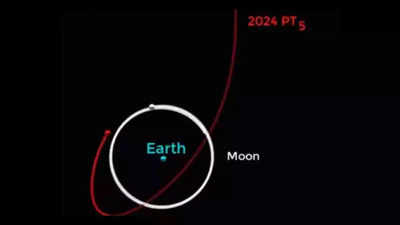In a rare celestial event, Earth has temporarily captured a second “moon” – an asteroid named 2024 PT5. This cosmic visitor will orbit our planet for nearly two months, offering astronomers and space enthusiasts a glimpse of the fascinating movements within our solar system. Here are seven key things every student should know about this intriguing phenomenon.
1.What Is 2024 PT5?
2024 PT5 is an asteroid that has been pulled into Earth’s orbit, making it a temporary moon, or “mini-moon.” Measuring approximately 37 feet (or 10 metres) in diameter, it is significantly smaller than Earth’s natural moon, which has a diameter of 3,476 kilometres. Discovered on August 7, 2024, by the Asteroid Terrestrial-Impact Last Alert System (ATLAS), 2024 PT5 hails from the Arjuna asteroid belt. Despite its nickname, this asteroid will only circle Earth for 57 days before resuming its journey through space.
2. A Short-Lived Orbital Companion
While Earth’s gravity captured the asteroid on September 29, 2024, it is expected to remain only until November 25, 2024. Unlike our moon, which completes a full revolution around Earth every 27.3 days, 2024 PT5 will not complete a single orbit. Its trajectory has been “twisted slightly” by Earth’s gravity, but it will soon break free and continue its path back into the Arjuna asteroid belt.
3. Too Small to See Without a Telescope
Although 2024 PT5 is a “mini-moon,” don’t expect to see it with the naked eye. Due to its small size and dim appearance, it can only be observed using professional-grade telescopes. Even standard amateur telescopes will struggle to capture this asteroid, according to astronomer Jennifer Millard. However, images and data from powerful instruments may soon be available online for curious skywatchers.
4. Recurring Visitors
Mini-moon events like 2024 PT5’s visit are not entirely unprecedented. Similar phenomena have been recorded in 1981, 1997, 2013, 2018, and more recently in 2022. Interestingly, 2024 PT5 is predicted to pass Earth again in 2055, showing that these asteroids often make repeat appearances.
5. The Asteroid’s Origins
2024 PT5 originates from the Arjuna asteroid belt, a group of Near-Earth Objects (NEOs) that share a similar orbit around the sun as Earth. This asteroid group is named after the legendary archer Arjuna from the Indian epic, Mahabharata, highlighting their swift and sometimes unpredictable movement through space.
6. Scientific Significance
The brief capture of 2024 PT5 highlights the busy and dynamic nature of our solar system. Thousands of objects pass close to Earth every year, but not all are detected. As Dr. Anil Kumar from ISRO’s Network for Space Objects Tracking and Analysis (NETRA) explains, monitoring these space rocks helps scientists understand potential threats and the overall behaviour of Near-Earth Objects. Such mini-moon events provide valuable insights into how asteroids interact with our planet’s gravity.
7. Why It Matters to Students
Understanding phenomena like 2024 PT5 offers students a practical glimpse into astrophysics, orbital dynamics, and planetary defence. This event also underscores the importance of space exploration and monitoring systems like ATLAS, which help scientists discover and track objects that could one day pose risks to Earth. As we continue to study these transient moons, students are reminded of the vastness and complexity of the solar system we live in.
A Cosmic Learning Opportunity
The temporary appearance of 2024 PT5 as Earth’s second “moon” offers a captivating window into our planet’s interactions with the broader universe. For students and aspiring astronomers, this mini-moon is a perfect example of how dynamic and full of surprises the solar system truly is. As we learn more about such events, it serves as a reminder that there is still much to discover about the space around us.






